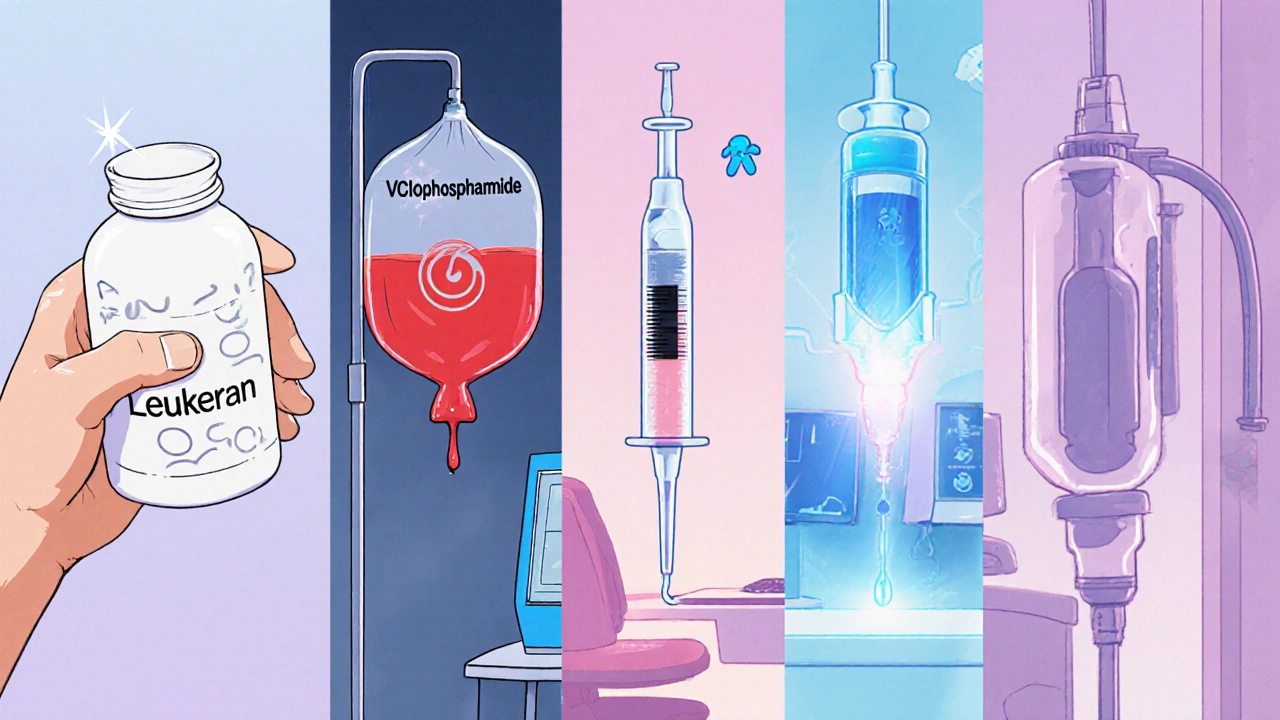Chemotherapy Treatment Selector
Choose your treatment priorities
Answer these questions to get personalized recommendations for your blood cancer treatment options.
Personalized Treatment Recommendations
When a doctor mentions Leukeran for a blood‑cancer diagnosis, it’s natural to wonder how it stacks up against other chemo options. This guide walks you through the most important differences-mechanism, dosing, side‑effects, and real‑world use-so you can have a clear conversation with your oncologist.
What is Leukeran (Chlorambucil)?
Leukeran is the brand name for chlorambucil, an oral alkylating agent that has been used since the 1950s to treat chronic lymphocytic leukemia (CLL) and some forms of lymphoma. The drug works by adding alkyl groups to DNA, which prevents cancer cells from replicating correctly.
Because it’s taken by mouth, Leukeran is often chosen for patients who prefer an at‑home regimen rather than frequent IV infusions. Its side‑effect profile is generally milder than many IV drugs, but it still carries risks such as bone‑marrow suppression and secondary cancers.
How Leukeran Works - A Quick Mechanism Snapshot
Chlorambucil belongs to the nitrogen mustard family. After absorption, it forms highly reactive intermediates that cross‑link DNA strands, causing breaks during cell division. Normal cells can repair some damage, but rapidly dividing blood‑cancer cells are more vulnerable, leading to tumor shrinkage.
Key Comparison Criteria
- Drug class - Alkylating vs. non‑alkylating.
- Administration route - Oral pill, IV infusion, or sub‑cutaneous.
- Approved indications - Specific cancers each drug treats.
- Typical dosing schedule - Daily, weekly, or cyclical.
- Major side‑effects - Myelosuppression, organ toxicity, etc.
- Convenience & cost - Home‑based vs. clinic‑based, generic availability.
Alternative #1: Cyclophosphamide
Cyclophosphamide is a widely used alkylating agent that can be given orally or intravenously. It’s approved for a broader set of malignancies, including breast cancer, lymphoma, and autoimmune disorders like vasculitis.
Unlike Leukeran’s once‑daily pill, Cyclophosphamide is often administered in a high‑dose IV burst every 2-3 weeks. This dosing schedule can cause more intense nausea, hair loss, and a higher risk of hemorrhagic cystitis, which is mitigated by giving the patient plenty of fluid and sometimes a protective agent called mesna.
Alternative #2: Melphalan
Melphalan is an oral or IV alkylating drug most famous for treating multiple myeloma and certain ovarian cancers. It shares the DNA‑cross‑linking action of Leukeran but is considered more potent, which means lower dosing schedules but a higher chance of severe bone‑marrow suppression.
Patients on melphalan often need growth‑factor support (like filgrastim) to keep neutrophil counts safe, and the drug can cause a distinctive taste‑alteration symptom known as dysgeusia.

Alternative #3: Busulfan
Busulfan is a highly lipophilic alkylating agent primarily used in conditioning regimens before bone‑marrow transplantation. It’s also employed for chronic myeloid leukemia (CML) when newer tyrosine‑kinase inhibitors aren’t suitable.
Busulfan is given either orally (as tablets) or intravenously, and therapeutic drug monitoring is essential because the therapeutic window is narrow. Too low a level fails to eradicate disease; too high a level can lead to irreversible lung fibrosis (pulmonary toxicity).
Alternative #4: Rituximab (Non‑Alkylating Option)
Rituximab is a monoclonal antibody targeting CD20 on B‑cells. Though not an alkylating agent, it’s often paired with Leukeran or used on its own for CLL and many non‑Hodgkin lymphomas.
Rituximab is delivered by IV infusion over a few hours, typically once weekly for four weeks, then monthly maintenance. Its side‑effects differ: infusion‑related reactions, hepatitis B reactivation, and rare progressive multifocal leukoencephalopathy (PML). Because it spares the DNA directly, it doesn’t cause the same long‑term secondary‑cancer risk as Alkylators.
Alternative #5: Fludarabine
Fludarabine is a purine analog chemotherapy frequently used for CLL, especially in patients who need a more aggressive approach. It interferes with DNA synthesis rather than cross‑linking.
Fludarabine is administered IV over several days, and it’s notorious for profound immunosuppression, making opportunistic infections a real concern. Combining it with cyclophosphamide (the “FC” regimen) can boost efficacy while balancing toxicities.
Side‑Effect Profile at a Glance
| Drug | Myelosuppression | Gastro‑intestinal toxicity | Secondary cancer risk | Unique concerns |
|---|---|---|---|---|
| Leukeran (Chlorambucil) | Moderate | Mild nausea | Low‑moderate | Oral adherence |
| Cyclophosphamide | High (IV high‑dose) | Significant vomiting | Low‑moderate | Hemorrhagic cystitis |
| Melphalan | High | Moderate | Moderate | Requires growth‑factor support |
| Busulfan | High | Mild | Low‑moderate | Pulmonary fibrosis |
| Rituximab | Low‑moderate (B‑cell depletion) | Minimal | Very low | Infusion reactions, hepatitis B reactivation |
| Fludarabine | High | Moderate | Low‑moderate | Severe immunosuppression |

Choosing the Right Drug for You
There’s no one‑size‑fits‑all answer. Your oncologist will weigh several factors:
- Age and overall health - Older patients often prefer oral Leukeran to avoid IV lines.
- Specific cancer subtype - CLL with low tumor burden may be managed with Leukeran alone, while aggressive CLL often needs fludarabine‑based combos.
- Prior treatment history - If you’ve already received an alkylator, switching to a non‑alkylating agent like rituximab can reduce cumulative DNA damage.
- Side‑effect tolerance - Patients who cannot tolerate severe nausea might avoid high‑dose cyclophosphamide.
- Lifestyle considerations - Daily pill adherence, travel plans, and access to infusion centers matter.
Open dialogue with your care team, ask about drug costs (many of these are generic and covered by insurance), and consider enrolling in clinical trials if standard options don’t fit.
Bottom Line Comparison Table
| Drug | Class | Typical Indication | Route & Schedule | Major Pros | Major Cons |
|---|---|---|---|---|---|
| Leukeran (Chlorambucil) | Alkylating (nitrogen mustard) | CLL, low‑grade lymphoma | Oral, 0.5‑2 mg daily | Convenient home dosing, lower acute toxicity | Long‑term secondary cancer risk, moderate myelosuppression |
| Cyclophosphamide | Alkylating (nitrogen mustard) | Broad - breast, lymphoma, autoimmune | IV pulse q2‑3 weeks or oral low‑dose daily | Effective for many solid tumors, flexible dosing | Hemorrhagic cystitis, higher nausea, IV requirement |
| Melphalan | Alkylating (nitrogen mustard) | Multiple myeloma, ovarian cancer | IV or oral, high‑dose cycles | Powerful anti‑myeloma activity | Severe marrow suppression, need growth‑factor support |
| Busulfan | Alkylating (nitrosourea) | CML, transplant conditioning | Oral or IV, monitored trough levels | Good for transplant prep, oral option | Narrow therapeutic window, lung fibrosis risk |
| Rituximab | Monoclonal antibody (CD20‑targeted) | CLL, non‑Hodgkin lymphoma | IV infusion weekly ×4, then monthly | Non‑DNA damage, synergistic with chemo | Infusion reactions, hepatitis B reactivation |
| Fludarabine | Purine analog | CLL, aggressive lymphoid malignancies | IV daily for 5 days per cycle | High response rates when combined | Deep immunosuppression, infection risk |
Practical Tips for Patients on Leukeran
- Take the pill with food to lessen stomach upset.
- Never skip a dose-missed days can reduce effectiveness.
- Schedule regular blood counts every 2-4 weeks; the lab will flag early marrow suppression.
- Stay hydrated and protect yourself from infections; use a mask during flu season.
- Ask your doctor about folic‑acid supplementation; it may help reduce anemia.
When to Switch or Add Another Agent
If you notice any of the following, bring it up with your oncologist promptly:
- Persistent low white‑blood cells (< 1,000/µL) despite dose holds.
- New‑onset skin lesions or unexplained bruising.
- Progression on imaging studies after 6‑12 months of stable dosing.
- Intolerable fatigue or nausea that interferes with daily living.
In many cases, a dose reduction or adding a targeted therapy (like ibrutinib) can salvage the regimen without fully switching drugs.
Frequently Asked Questions
Is Leukeran still used in 2025?
Yes. Although newer oral agents like venetoclax have entered the market, Leukeran remains a guideline‑recommended option for low‑risk CLL patients who need a simple, low‑toxicity therapy.
How does the effectiveness of Leukeran compare to rituximab?
Rituximab generally produces faster, deeper responses because it directly eliminates B‑cells. However, it requires IV infusions and can cause infusion reactions. Leukeran offers a slower but steady disease control with the convenience of a pill.
Can I take Leukeran while pregnant?
No. Alkylating agents are classified as Category D or X for pregnancy because they can cause birth defects. Discuss contraception or alternative therapies with your doctor.
What monitoring is needed on Leukeran?
Complete blood count (CBC) every 2-4 weeks, liver function tests every 2-3 months, and periodic imaging if disease burden is being tracked.
Are there generic versions of Chlorambucil?
Yes. After the original patent expired, multiple manufacturers produce generic chlorambucil tablets, which are usually covered by insurance and cost far less than brand‑name Leukeran.
Armed with this side‑by‑side view, you can discuss the trade‑offs with confidence and help your treatment team tailor the best plan for your situation.


Tracy O'Keeffe
October 18, 2025 AT 20:43Honestly, while the guide glorifies Leukeran as a quaint oral relic, the reality is that its pharmacokinetic profile is riddled with variability that most clinicians conveniently gloss over. The drug's bioavailability swings like a pendulum, and you’ll find patients stumbling through sub‑therapeutic troughs, especially when adherence wanes under the guise of convenience. Moreover, the so‑called "milder" side‑effect tableau belies the insidious risk of secondary neoplasms that manifest years later, a fact buried in the footnotes of most oncology textbooks. If you’re seeking a truly modern regimen, you might as well turn your attention to the latest BTK inhibitors, which, despite their price tag, offer a more predictable safety canvas. So, before you crown Leukeran as the under‑dog hero, ask yourself whether you’re trading one set of uncertainties for another.
Albert Fernàndez Chacón
October 20, 2025 AT 00:30Leukeran can be a solid option for patients who want an oral pill instead of an IV line. It’s less intense than high‑dose cyclophosphamide and usually has milder nausea. Just keep an eye on blood counts every few weeks, because the bone‑marrow suppression can still be moderate. If you have other health issues, talk to your doctor about how it fits your overall treatment plan.
alex montana
October 21, 2025 AT 04:16Wow!!! This whole chemo landscape is like a maze-so many drugs, so many side‑effects… you feel overwhelmed, right? Yet every option, from Leukeran to cyclophosphamide, carries its own saga of hopes and pitfalls. The oral route of Leukeran feels like freedom, but then-bam!-myelosuppression can hit hard; and don't even get me started on the hidden risk of secondary cancers that linger like a ghost. Why do we even keep using these old‑school alkylators when newer targeted therapies are out there? It’s like clinging to a flip‑phone in a smartphone era…
Wyatt Schwindt
October 22, 2025 AT 08:03Oral Leukeran beats IV hassle for many seniors.
Lyle Mills
October 23, 2025 AT 11:50The key with Leukeran is monitoring myelosuppression while balancing quality‑of‑life. Its oral regimen reduces hospital visits, which is a big plus for patients with limited mobility. Still, you need regular CBCs to catch any drop in neutrophils early. In practice, many clinicians combine it with rituximab to boost response without adding excessive toxicity.
Barbara Grzegorzewska
October 24, 2025 AT 15:36Let me set the record straight-American oncology has always been at the forefront, and Leukeran is a testament to that pioneering spirit. While Europeans love to romanticize "old‑school" drugs, we know that a well‑managed chlorambucil regimen can hold its own against flashier, costlier therapies. Sure, it’s not a miracle cure, but it’s reliable, affordable, and makes sense for a broad swath of the population. Stop whining about side‑effects; if you stay diligent with labs, the risks are manageable. And for the love of liberty, let’s not forget the patriotic pride in using a domestically produced generic that saves taxpayer dollars.
Nis Hansen
October 25, 2025 AT 19:23Consider the philosophical underpinning of treatment choice: we are not merely battling malignant cells, we are navigating the existential tension between hope and risk. Leukeran offers a bridge between aggressive chemotherapy and watchful waiting, embodying a middle path that honors patient autonomy. By embracing its oral convenience, we empower individuals to reclaim agency over their daily lives while remaining vigilant through regular monitoring. Let this serve as a reminder that medicine is as much an art of compassion as it is a science of efficacy.
Avril Harrison
October 26, 2025 AT 22:10From a cultural standpoint, the preference for oral therapies reflects a broader shift towards patient‑centered care in many societies. People appreciate the ability to take medication at home, integrating treatment into their daily routines without frequent hospital trips. This trend also aligns with the growing emphasis on tele‑health follow‑ups, which make blood‑count monitoring more accessible worldwide.
Sarah Hanson
October 28, 2025 AT 01:56Dear colleagues, I echo the sentiment that systematic monitoring is paramount when prescribing Leukeran. Adherence, laboratory surveillance, and patient education together form the triad of effective management. Let us strive to maintain these standards across all practice settings.
Nhasala Joshi
October 29, 2025 AT 05:43🚨🧠 Ever wonder why the pharma giants push newer, pricier drugs while keeping old staples like Leukeran on the shelves? It's a classic control tactic-keep the public guessing and reliant on ever‑changing treatment narratives. The truth is, many of these "innovations" are just rebranded versions of the same alkylating chemistry, repackaged to line the pockets of the elite. Stay vigilant, read between the lines, and never accept the hype at face value. 🌐💊
Linda A
October 30, 2025 AT 09:30When one contemplates the ontology of chemotherapeutic choice, it becomes evident that each agent is but an expression of underlying metaphysical principles. Leukeran, as an oral alkylating agent, embodies the principle of accessibility, allowing the patient to integrate treatment into the mundane flow of daily existence. Yet this very accessibility conceals a paradox: the ease of ingestion masks the profundity of its DNA‑cross‑linking mechanism, which quietly undermines the very fabric of cellular replication. In contrast, intravenous regimens such as cyclophosphamide demand a ritualistic encounter with the clinical setting, reinforcing the patient's awareness of their vulnerability. This awareness can be both a source of anxiety and a catalyst for empowerment, depending on the individual's narrative framework. Moreover, the specter of secondary malignancies looms like an existential dread, reminding us that each therapeutic decision is a negotiation with future uncertainty. The clinician, therefore, must act as a hermeneutic mediator, translating statistical risk into a story that the patient can inhabit. By doing so, the patient is not merely a passive recipient of cytotoxicity but an active participant in a shared epistemic journey. When considering adjuncts such as rituximab, one observes a shift from cytotoxicity to immunomodulation, suggesting an evolution in the philosophical underpinnings of oncology-from brute force to nuanced orchestration. However, the infusion of monoclonal antibodies introduces its own ritual, with infusion reactions symbolizing the body's resistance to external manipulation. Ultimately, the choice between oral convenience and intravenous intensity is a dialectic between autonomy and surrender, each bearing its own ethical weight. The patient must weigh the tangible benefits of home administration against the intangible costs of potential non‑adherence. In this weighing, the temporal dimension of chemotherapy-cycles, weeks, months-becomes a canvas upon which life narratives are painted. Thus, the decision is not purely pharmacologic but also existential, demanding reflection on what it means to live with, and perhaps beyond, the shadow of disease.